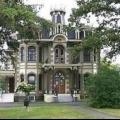 Early Steps in Cowansville's Development
Early Steps in Cowansville's Development
Cowansville's history begins in 1798 with the arrival of the first settler, Jabob Ruiter, the son of a Loyalist. In 1800, Ruiter built a flour mill and sawmill on the south shore of the Yamaska River, near the site of the present bridge on South Street. The mill contributed a lot to the community's economy.In 1805, Ruiter named the place Nelsonville, in honor of British naval hero Lord Horatio Nelson who was killed in action in the battle of Trafalgar on October 21, 1805.
Peter Cowan, a Montreal mechant, arrived in Nelsonville in 1836. At that time, there where only four houses in the village. On February 6, 1841, Cowan opened the first post office in Nelsonville. He named the post office "Cowansville" so that the mail would not get confused with mail going to Nelson, near Hamilton, in Upper Canada (Ontario). Gradually the village came to be known as Cowansville. The first postmaster was H. Barney who quit after the first day. On February 7, 1841, Peter Cowan became the second postmaster. He remained in that position until 1861.
Sweetsburg Court House emerged in 1861.The cases of the Bedford District (Shefford, Brome and Missisquoi) were held there.The village grew quickly thanks in part to the Cowansville Observer, a newspaper founded in 1870. Other events, such as the construction of the South Eastern Railway, linking Montreal to Cowansville, and the establishment of a branch of the Eastern Township Bank, contributed to the town's expansion. The first train of the South Eastern Railway arrived in Cowansville on November 26, 1870 at 5 pm.
On January 1, 1876, the village was incorporated and Cowansville become its official name.